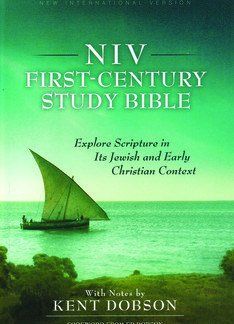The market for study Bibles is a crowded one, but this is a unique entry. Its subheading is ‘Explore Scripture in its Jewish and early Christian context’. The general editor, Kent Dobson, spent years studying in Jerusalem (he now pastors a church in Michigan) and seems well qualified to offer such insight.
Features common to study Bibles are included (page-by-page commentaries, maps, charts, individual book introductions). This edition, however, also has ‘word study’ articles and ‘A day in the life of’ articles. The latter depicts the life and times of, among others, desert shepherds, Hebrew children, Galilean fishermen and the Essenes. Providing contemporary contexts are hallmarks of this study Bible.
Another trend in its approach is its focus on early interpretations of scriptural texts. This lends a freshness and novelty to the annotations, but sometimes they stray into the outlandish. For example, commentary on Genesis 4:1 includes: ‘One would expect the text to say that Eve gave birth to “a son”, not “a man”. Ancient interpreters tried to explain this phrase by positing that Eve actually slept with the serpent or one of the fallen angels and did in fact give birth to a man’ (p.10). Interesting? Fairly. Helpful? Unlikely. Valid? Hardly.
Nonetheless, much of the commentary offers illuminating information. For example, the notes on Jesus’ encounter with the Samaritan woman in John 4 include: ‘Josephus described serious tensions between Jews and Samaritans, including Samaritan attacks on Jewish pilgrims travelling to Jerusalem … During one Passover, Samaritans scattered bones on the Temple Mount in order to desecrate the festival’ (p.1346).
The commentary also seeks to raise questions about the text as much as answer them. The annotation of the tenth commandment in Exodus 20 reads: ‘Is it possible to legislate desire? It’s interesting that the Bible takes seriously the desire to sin, as well as the direct action’ (p.110).
This edition’s approach to scriptural authorship is a concern, however. The various theories and speculations of ‘higher criticism’ are favourably presented. Concerning the Pentateuch, the theory that many authorial hands were involved — Moses himself being described as merely ‘some type of author’ (p.272) — is explored. A similar view is taken of Gospel authorship: ‘How they [the Gospels] came to be, who wrote them … has long been a matter of scholarly debate’ (p.1187). Of Revelation, the apostle John is said to be ‘possibly’ the author (p.1602).
Having said those things, the production of this Bible is excellent. It abounds with full-colour photos, coloured charts and detailed maps, all printed on tinted paper, intended to help present the Scriptures as a historical document rooted in the ancient past.
In summary, this would make intriguing reading for more mature Christians seeking to further their understanding of its early contexts. However, as its commentary is very light on doctrine and personal application, I would recommend alternative study Bibles for newcomers to this market.







